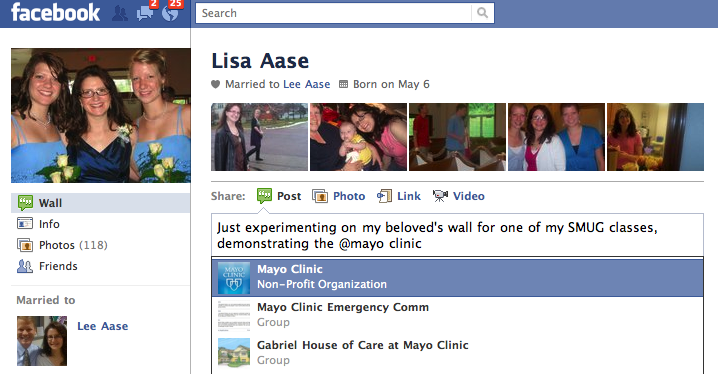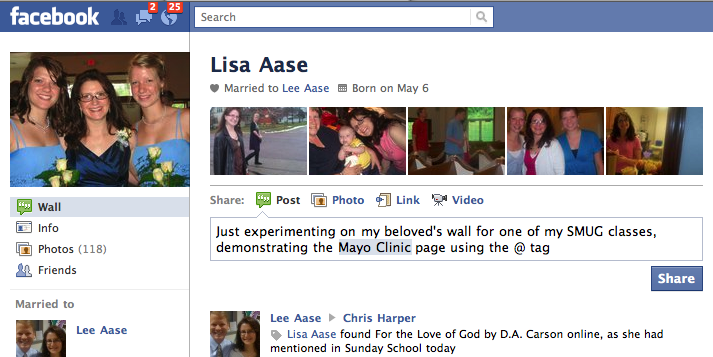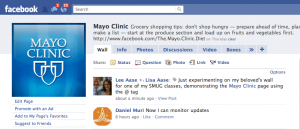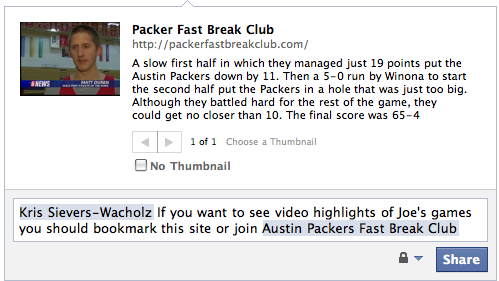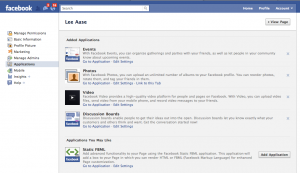Those who have used Twitter are familiar with the @ lingo: When you put @username (e.g. @LeeAase, @MayoClinic, @MeredithGould) in a tweet, you are replying to or mentioning that Twitter user in the public space.
Facebook developed similar functionality several months ago, but I have to confess I haven’t used it as much or as well as I should.
Hearing my friend Alan De Keyrel mention the @ tag in Facebook as a key strategy for building connections caused me to take a more in-depth look. I think it’s definitely something people in charge of maintaining Facebook pages for an organization should be exploring and using.
As with all powerful tools, it can go terribly wrong if abused. So in this course I’m going to give the overview of
- how the @ tag works,
- some ways it could be used productively, and also
- some cautions on what to avoid.
How it works:
When you are posting a link or a status update to your wall in Facebook, you can create a link to any of your friends’ Profiles, Pages you like or groups to which you belong, by typing @ in your update and waiting for a list of relevant pages or friends or groups to appear. It will look something like this:
When you hit your enter key to select the relevant page, profile or group, the update will look like this, just before you post it:
The cool thing is that this shows up not only where you posted it directly, but also on the linked pages. Here’s how it appeared briefly on the Mayo Clinic page (before I quickly removed it):
And here’s what it looked like on my wife Lisa’s wall:
How the @ tag can be used productively:
The @ tag is essentially like tagging an individual in a photo, but it goes beyond that. It’s a great way to share content with your friends and with their friends.
So, for example, I just posted a link to the Austin Packers Fast Break Club site (a blog we use to share highlights from my son’s high school basketball team) to my sister-in-law’s Facebook profile using the @ tag:
You will note that I tagged both Kris and the Facebook group for the Fast Break Club. Here’s what it looked like on her wall:
As you can see, this can be a really powerful way of spreading information on Facebook. But as Uncle Owen told Peter Parker, “With great power comes great responsibility.” This leads us to the third point:
Cautions on what to avoid in using the @ tag
Mainly, don’t think like an advertiser. Advertisers look for ways to interrupt people and push their messages, whether the recipient wants them or not.
In my first example above, I did post something to Lisa’s wall that may not have been all that interesting to her, although I did refer to her as my beloved. She understands when I need to experiment. Part of the price of being married to the Chancellor.
In the second post, though, I was sharing something with my sister-in-law about her nephew’s basketball team. I had every reason to expect she would find it interesting and welcome.
The side benefit is that some of her friends, such as other family members, will see this on her wall and may also like it. They may also decide to join the Facebook group or subscribe to the blog.
If I just started randomly tagging other friends in the post, that would have been a quick way to lose friends and not influence people.
The same is true for your use of @ tags relating to your organization’s page. It’s one thing if your friends or page connections decide to tag your page on their profiles, or tag their friends in a post or status update. It’s completely different when you use the @ tag to spam pages or profiles.
It all comes down to not being “that guy”
Think like a real person. If you’re using the @ tag mainly to drive traffic and not to connect people to information that will be interesting to them, your effort will not be successful in the long run.
But used wisely and with integrity, the @ tag can play a significant role in helping you make connections with people who share your concerns and convictions.
